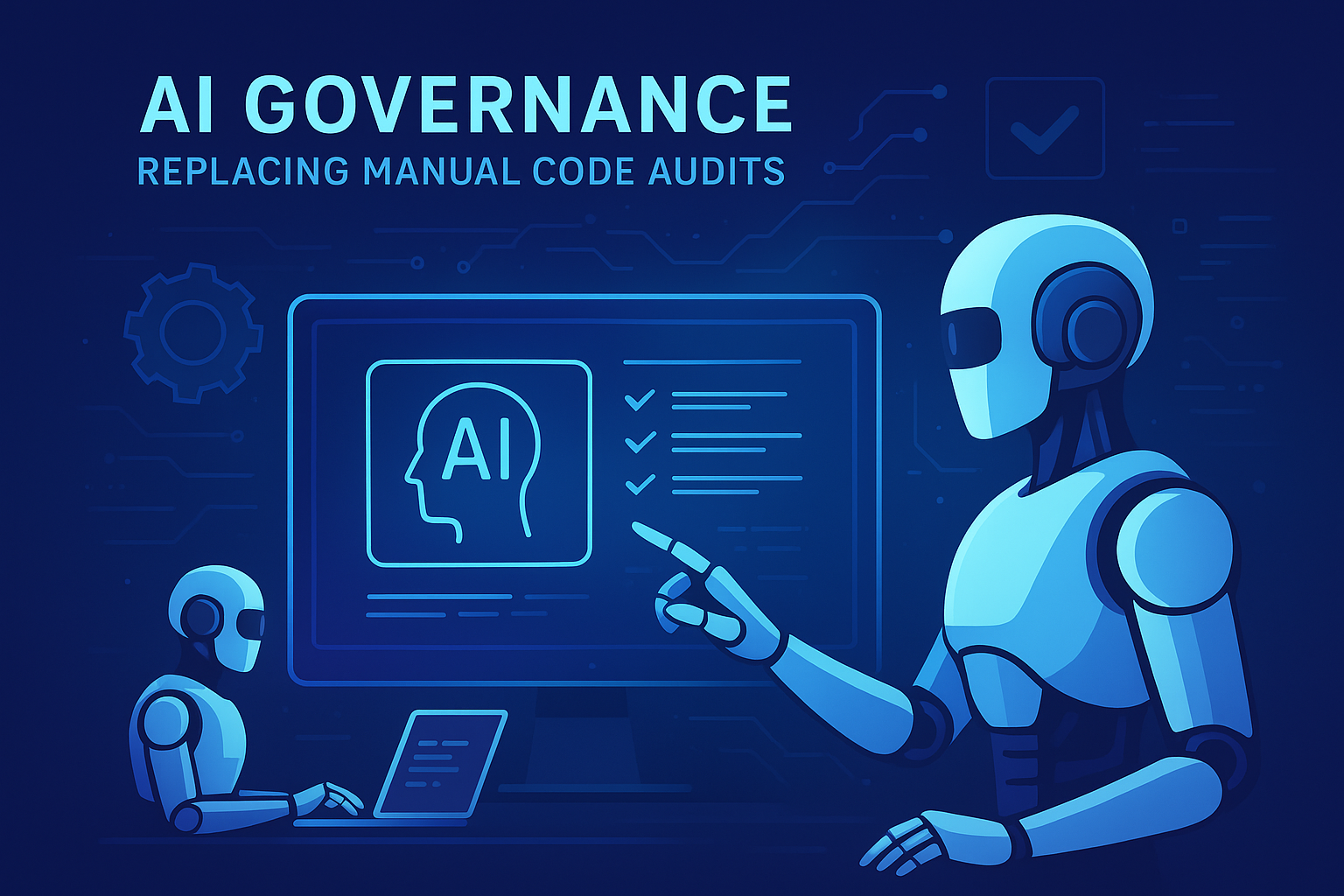Software teams are moving faster than ever. New features, updates, and patches roll out daily, yet compliance standards and security regulations are only getting stricter. For decades, manual code audits were the safety net—humans painstakingly reviewing every line for bugs, vulnerabilities, and compliance gaps. But in 2025, that model is starting to collapse under its own weight. Enter AI governance: automated tools that don’t replace humans but fundamentally change how code quality and compliance are maintained.
In this era of continuous delivery, fast feedback is everything. AI governance tools are no longer futuristic. They’re essential for companies that want to innovate quickly without risking compliance or security lapses.
Why Manual Code Audits Are Failing Us
Manual audits once made sense when software changes were periodic, features fewer, and scale smaller. But today:
- Slow feedback loops: Waiting days or weeks for audits delays shipping, causing technical debt to accumulate and compliance standards to drift. Developers often finish a sprint only to discover multiple issues piling up, forcing late-stage rework.
- High cost, limited coverage: Expert auditors are expensive. Large, distributed codebases make full coverage nearly impossible without a huge budget. Many teams end up sampling parts of the code, leaving gaps.
- Human error & fatigue: Even the most diligent auditors make mistakes under pressure or when reviewing complex pull requests with intricate dependencies.
- Rigid, static processes: Manual audits follow fixed templates. When regulations change, updates must be applied manually, creating lag and increasing risk exposure.
The result: slower releases, inconsistent compliance, and a growing backlog of audit issues that often gets ignored until the last minute.
The AI Governance Shift: What It Looks Like
Replacing or augmenting manual audits with AI governance transforms workflows in several ways:
- Real-time code feedback: Developers receive immediate feedback as they write code. Violations of code quality, best practices, or regulatory rules are flagged instantly, removing the bottleneck at the end of a sprint.
- Automated compliance checks: AI parses complex rules like OWASP, GDPR, HIPAA, or internal corporate policies. Missing input validation, insecure data handling, or unapproved third-party dependencies are detected automatically.
- Continuous monitoring and alerting: Dependencies, new vulnerabilities, and regulatory shifts are continuously scanned. Teams are alerted as soon as a risk arises, not weeks later.
- Scalability & consistency: AI applies the same rules across multiple teams, languages, and repositories. The inconsistencies and biases introduced by different human auditors are eliminated.
Think of AI governance as a co-pilot: handling repetitive, high-volume checks while humans focus on nuanced decisions, ethical trade-offs, and strategic review.
Concrete Examples of AI Governance in Action
Some real-world scenarios highlight the impact of AI governance:
- Open-source dependency scanning: A developer adds a new library. The AI automatically checks licenses, known vulnerabilities, and compliance with internal policies, preventing legal and security risks.
- Sensitive data detection: A pull request contains code that logs personally identifiable information (PII). AI flags it immediately, helping teams stay GDPR-compliant.
- Coding standard enforcement: Language-specific best practices, like avoiding deeply nested callbacks in JavaScript, are enforced directly in the IDE. Developers see issues inline and can fix them instantly.
- Automated remediation suggestions: Some tools go further, suggesting fixes or generating safe boilerplate code. This reduces friction and back-and-forth in reviews, reducing PR cycle time.
- Continuous reporting dashboards: Teams can track compliance health metrics, like the percentage of PRs with violations or average time to remediation, giving leadership a clear picture of risk.
AI governance doesn’t just catch mistakes. It teaches developers better practices over time, creating a feedback loop that improves the overall quality of the codebase.
How the Market Is Moving
The shift toward AI governance is accelerating:
- Growing investment & tools: Vendors offer AI-powered compliance engines that integrate security scans, licensing checks, and style enforcement into CI/CD pipelines.
- Regulatory pressure rising: Governments are tightening data privacy, supply chain security, and open-source licensing regulations. Companies must comply faster and more reliably to avoid fines or reputational damage.
- Developer expectations changing: Developers want feedback as they code, not weeks later. Continuous AI-driven audits reduce the friction between innovation and compliance.
- Upskilling and hybrid roles: Compliance officers, security engineers, and developers increasingly collaborate on AI-driven tools. Traditional “auditor” roles are evolving into “governance engineers” or “policy-as-code developers.”
Companies embracing AI governance see measurable improvements in speed, risk management, and developer satisfaction.
What AI Governance Might Look Like by 2030
Imagine this near-future scenario:
- Every pull request is scanned instantly. Violations, security risks, and licensing issues appear inline.
- Policies are encoded as policy-as-code. Updates propagate automatically when regulations change.
- Dependency graphs track third-party packages; any vulnerable library triggers immediate alerts.
- Continuous dashboards provide executives with metrics: percentage of PRs with violations, average remediation time, and compliance trends.
- Humans focus on high-risk or ambiguous cases: ethical trade-offs, complex business logic, and scenarios requiring judgment.
Early adopters are already seeing the benefits: faster releases, fewer errors, and stronger compliance posture.
Trade-Offs, Challenges & What Teams Should Do Now
AI governance isn’t magic. To succeed:
- Define clear, maintainable rules: Ambiguous rules create false positives and noise. Codifying policies properly is essential.
- Trust but verify: AI can miss issues or produce false positives. Human oversight is still critical, especially for high-risk domains.
- Manage cultural change: Developers may resist AI “policing.” Positioning it as a tool for faster delivery and higher-quality code reduces friction.
- Invest in training: Teams must understand security, compliance, and how to act on AI feedback. Governance tools only help if humans make informed decisions.
Conclusion: Transitioning from Manual Audits to Continuous AI Governance
The death of manual code audits will be gradual, not sudden. By 2030, most audits will be continuous, powered by AI tools, policy-as-code, and integrated observability. Teams that delay this shift risk slower releases, higher compliance costs, and increased security exposure.
AI governance isn’t just a tool—it’s a mindset shift. Teams that embrace it gain speed, consistency, and confidence, ensuring that compliance and quality scale alongside innovation.
Ready to evolve your code audits? Start small: integrate AI governance into one repository, codify your top compliance rules, and see instant feedback for your developers. The faster you start, the sooner you’ll free your team from manual audits—and stay ahead in the age of continuous delivery.






